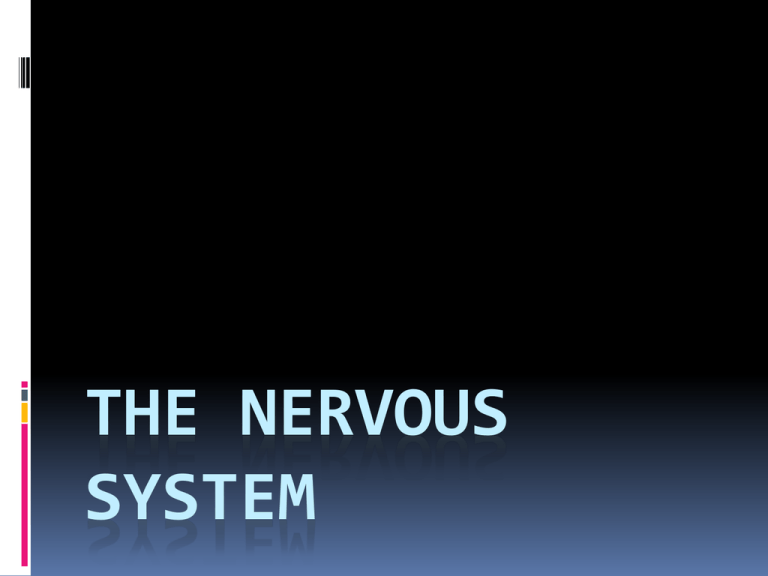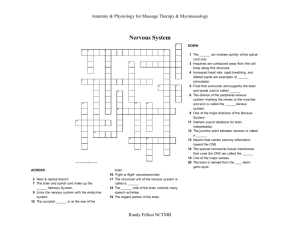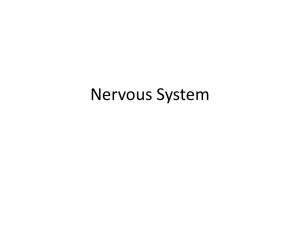The Nervous System
advertisement

THE NERVOUS SYSTEM Functions The body’s communication network and control center Controls all actions and functions of the body Senses change and allows your body to respond within a fraction of a second Neurons Sensory Neurons: carry signals from sense receptors into the CNS Motor Neurons: carry signals from CNS to muscles or glands Interneurons: form all the electrical connections within the CNS itself Structure Two main divisions : central nervous system and peripheral nervous system Central Nervous System Contains the brain and the spinal cord Receives and analyzes information and initiates the responses of the body Parts of the brain include the cerebrum, cerebellum and brain stem Cerebrum Site of the most conscious and intelligent activities Conscious thoughts take place on the outer layer of the brain or the cortex Divided into two hemispheres: Right and Left The right hemisphere controls the left side of the body and the left hemisphere controls the right half of the body Cerebellum Second largest part of the brain Divided into two hemispheres Helps with maintaining balance, posture and coordinating skeletal muscle movement The Brain Stem 3 inch long stalk of nerve cells and fibers that connects the spinal cord to the rest of the brain Pathway for messages traveling between other parts of the brain and the spinal cord Controls breathing, heartbeat, and eye reflexes Consists of the medulla oblongata, pons, midbrain, thalamus, and hypothalamus Medulla Oblongata Lowest part of the brain stem Contains vital control centers that control heartbeat, breathing, blood pressure, and digestion Also controls swallowing , vomiting, sneezing, and coughing Involved in speech and tongue movements Pons Above the medulla Serves mainly as a pathway for nerve impulses passing to and from the cerebrum Relays sensory information from the ear, face, and teeth Adjusts facial expressions Midbrain The shortest part of the brain stem, lies above the pons Controls eye movements and the size and reactions of the pupils Thalamus Located above midbrain Relay center for incoming sensory impulses Receive information from the eyes and ears Through the spine, also receives information from touch and pressure receptions Hypothalamus Under the thalamus, -hypo- means under Regulates body temperatures, stimulates appetites for food and drink, and regulates sleep Controls secretions from pituitary glands that control processes such as metabolism and sexual development Peripheral Nervous System main parts: 1. Autonomic nervous system 2. Somatic nervous system Autonomic Nervous system Responsible for controlling the involuntary functions of the body such as sweating digestion, and heart rate Divided into two parts: Sympathetic Parasympathetic Sympathetic Responds tot the body’s needs during increased activity and emergencies “Fight or Flight” response During the fight or flight response heartbeat and breathing rate quickened Blood flow to the muscles increase Parasympathetic Nervous system Slows body functions Slows down heartbeat, opens blood vessels, and lowers blood pressure Somatic Nervous System Includes cranial and spinal nerves that transmit impulses from the CNS to the skeletal muscles Voluntary : responses that are under your control Reflex Action A reflex is a spontaneous response of the body to a stimulus Occurs automatically Ex: when the doctor taps your knee and it makes your leg kick Ex: when your hand touches a hot stove an impulse is send to your brain and to take your hand off







